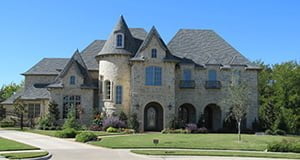Hailstorms can produce significant damage to roofs, windows, and automobiles. You see them arise more during the spring and summer months when winds take droplets of moisture to higher levels of altitude and lower temperatures.
The droplets accumulate against one another, becoming so heavy the atmosphere can no longer sustain them. At that point, they crash to earth with such speed and ferocity that they impact structures, roofs, and windows before having a chance to melt.
Imagine throwing a golf ball downward from several thousand feet. It could destroy anything it touches! Fortunately, from a roofing perspective, there are steps you can take to avoid the worst.
Picking the Right Shingle
Ideally, you want a shingle that has a Class 4 impact rating. That’s a prerequisite if you hope to avoid frequent (and expensive) repairs. While these shingles may cost more upfront, they are the industry standard for safety, and many insurance companies will give you a discount for employing such materials.
With Class 4 firmly on the brain, here are some of our favorite material types to reduce the effects of impact without sacrificing cosmetics.
Non-Metal and Metal Roofing Materials
In the world of roofing, there are metal and non-metal roofing materials. Most of you will go the non-metal route for homes and small businesses. Here are some of our favorites, but this list is by no means exhaustive:
- Cedarwood shakes
- Asphalt
- Polymer roof panels
- PVC roofing membrane
- Asphalt-coated fiber
- Plastic
- Rubber
Here’s the list of manufacturers and specific product types that help with your insurance, according to the Texas Department of Insurance. This link applies to metal roofing materials as well. Here are some of our favorites in that area:
- Formed steel panels
- Stone-coated steel roofing panels
- Presidio steel tile, shake/slate
- Copper panels
How Testing Is Conducted
The UL 2218 Class 4 Impact Rating is derived from a simulation using 2-inch steel balls. The steel gets dropped on the same spot of a shingle twice before it’s checked for degradation (i.e., loss of granules, cracking, splitting, breaking). There are several approved testing sites in the US and Canada, with two in Texas at Southlake and San Antonio.
There Is Just One More Thing to Do
If you want a quality roof, then getting the right materials is only half of the challenge. You’re also going to need a trustworthy contractor. At Griffith Roofing, we’ve been demonstrating and earning that trust for two decades and counting. Contact us today to learn more.
[Featured Image by Wikipedia Commons]



